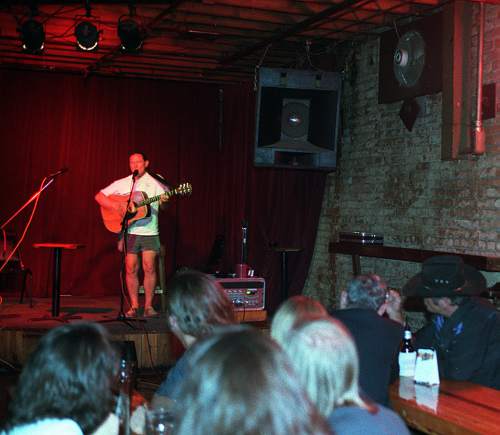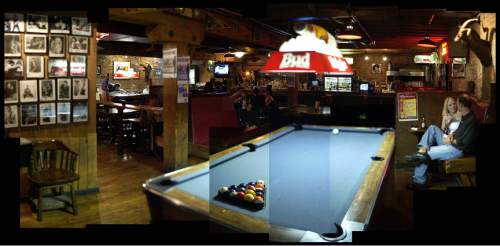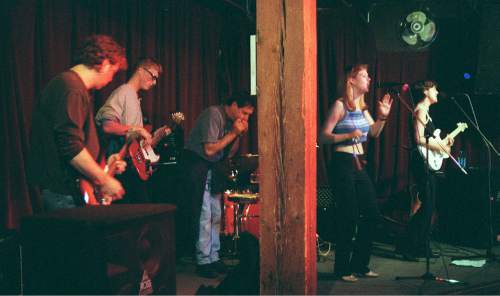This is an archived article that was published on sltrib.com in 2016, and information in the article may be outdated. It is provided only for personal research purposes and may not be reprinted.
It was tucked away in the basement of a building at the back of Arrow Press Square in the heart of downtown Salt Lake City — and that only stoked its popularity.
You practically needed a map to find The Dead Goat Saloon down a dark alleyway. It was as if only cool people would know about the place.
As it turned out, there were lots of cool people.
The Dead Goat opened in 1973, and was soon the place to be for college students and other young people on Friday and Saturday nights. New and old friends alike jammed into the place to swill pitchers of beer and share a few laughs to a soundtrack provided by The Rolling Stones, Bob Dylan, and Crosby, Stills, Nash and Young.
Amid that crazy din, many relationships — long and short — were hatched: the mark of a good watering hole.
In the '90s, The Goat morphed into the premier venue for blues in the salty city. It wasn't exactly the famed juke joint Ground Zero in Clarksdale, Miss., but it did attract national acts, including Buddy Miles, Long John Hunter and W.C. Clark. The blues legends and their music added a heavy and hip dimension to the place found nowhere else in the capital city — or in Utah for that matter.
For most of the 1980s and early '90s — particularly before the Utah Jazz's current arena was built — The Goat also served as an unofficial postgame hangout during the NBA basketball season. Detroit Pistons center Bill Laimbeer left his signature there along with other pro players. A cadre of traveling sportswriters, including the Chicago Tribune's Sam Smith, also dropped anchor there.
The Goat was right across West Temple from the old Salt Palace — the Jazz's former home. That also was during the era of so-called private clubs, where members could order up something stronger than beer.
But Smith and his colleagues didn't frequent those clubs, apparently unaware they could pop their heads inside any one of those establishments and immediately get sponsored for the evening.
"It was dark and dingy," Smith recalled of The Goat. "It was a hideaway. You got the sense it was a place you could go and not be seen drinking," he said, referring to Utah's predominant Mormon culture.
The saloon was known, too, for its beautiful long bar, where you could belly up for a brew and a Goat Burger and stare at a goat skull (or was it a ram's skull?) behind the bartender. On a quiet weeknight, you could drown your sorrows with whomever you bumped into and swap stories of getting dumped, dropping out and future job prospects, to say nothing of potential conquests.
Rob Green was a college student in the '70s and recalls good times playing shuffleboard and foosball. The saloon's game room also sported a pool table.
"It wasn't a standard bar, and it wasn't high zoot," he said, describing the clientele of students, hippies and construction crews. "We'd go down there and wager on shuffleboard."
Overall, Green said, he came out a loser, blaming the shuffleboard hustlers — who, like pool sharks, would, over the course of several beers, lull their prey into a false sense of confidence.
It was around 1990 when John Paul Brophy, who wrote music reviews for The Salt Lake Tribune, bought an ownership stake in the place. He soon partnered with Michael Ricks, who had worked for the saloon mostly on the music and entertainment side.
The two put their energies into developing The Dead Goat as a blues venue. It boasted an intimate setting where patrons could get up close with blues players and other musicians.
"We bridged a gap in the West," Ricks said. "We invited a lot of influential black artists who were into the blues."
Soon, The Goat became a stopover for touring blues acts from across the country. Nonetheless, almost any type of music was welcome, including such greats as Levon Helm, the drummer and vocalist for The Band — best known for his singing of "The Weight," one of group's signature anthems.
Many others played The Goat, too. "One of the great things was Los Lobos was playing at the fairgrounds," Brophy recalled. "I brought them over and they played all night."
The saloon's owners also sought to promote Utah musicians and acts, Ricks noted. Midweek, they would sponsor "New Band Night." On the last Monday of the month, The Goat would broadcast live music on KRCL.
"It wasn't about the booze and the women; it was about the music," Ricks said. "It was like a melting pot. Everybody felt welcome there."
But if all good things come to an end, this one did as well. By the end of 2003, Salt Lake City-based attorney Daniel Darger had assumed control of the saloon. He changed the name to The Crazy Goat and reopened it as a strip club. A legal squabble ensued and, in 2004, Darger and The Church of Jesus Christ of Latter-day Saints sued each other.
The saloon's inglorious end makes one-time Dead Goat regulars — not to mention the likes of Brophy and Ricks — cringe. They miss the place, the good times and can almost hear Helm wailing:
"I pulled into Nazareth, was feelin' about half-past dead.
"I just need some place where I can lay my head.
" 'Hey, mister, can you tell me where a man might find a bed?'
"He just grinned and shook my hand, 'no' was all he said."











